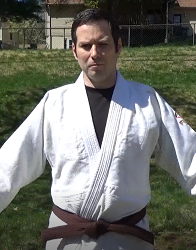Fundamentals: the gi
Understanding the proper way to wear the gi and its parts.
Continue reading
Gedan Barai
Gedan barai protects your midsection from attack, but it's crucial to understand the fundamentals of this technique.
Continue reading
Mae Geri - Front Kick
The front-kick is useful both for defense and attack. Use it to gauge an opponent's distance, or to finish the fight.
What is "Mae geri"?
To understand mae geri let's break down the name into it's proper parts. Mae means 'before' or 'in front of'. Keri means 'kick'. When keri is used after another word it changes to geri. Do not, however, make the all-too-common mistake of assuming that Geri in the begining of a word means 'kick'; it actually means 'diarreah'. Keri-waza (kicking techniques) is definitely not the same as geri-waza!
So mae geri is a 'front kick' or 'kick to the front'.
Types of Mae Geri
There are 2 principle types of mae geri: mae geri kekomi and mae geri keage. Keage is a rising or upward-moving kick, often referred to as a 'snap kick', whereas kekomi is a thrusting or 'push kick'.
Both keage and kekomi variations on mae geri are fast kicks and easy to execute as they have a more 'natural' feel to their motions. In fact, both of these kicks can be thrown from either the lead or rear leg.
Use the chosoku, or ball of the foot when executing these kicks.
Mae Geri Keage
The "snap kick", as mae geri keage is often called, is executed with a rising or snapping motion. This technique is more of a 'breaking' technique than the kekomi as it focuses speed against the point of impact.
To execute this kick, raise the knee so that it is pointing toward your target (chambered). Straighten the knee with the toes pointing back toward your body. As soon as the kick connects with the target return the foot back to the chambered position and place the foot back to the ground. It is important to intentionally place your foot rather than just letting it fall to avoid injury.
This kick can easily be thought of as a 'jab' for the feet. You can use it to gauge distance with an opponent prior to using other kicks. It could also be used against the sternum or diaphragm to knock the breath out of your opponent, or against the chin in an attempt to render an opponent unconcious.
Mae Geri Kekomi
Mae geri kekomi is a 'push kick'. This kick uses the hips and thighs to push an opponent backward.
For this kick, chamber the leg in much the same way that you would for keage, but instead of relying on the snapping motion of the knee propel the hips forward and extend the knee as the ball of your foot impacts its target.
This kick has several targets and applications. If an opponent is rushing toward you, use this kick to the diaphragm to not only push the opponent back, but to take away their breath. Alternatively, you could target the groin with this kick in a self-defense situation. If you prefer kicking as opposed to closer-range strikes (knees, punches, elbows or grappling) and your opponent is in the mid-range (punching distance) you can use this kick against their midsection to force them away from you so you can follow up or escape. You can also target the top of the thigh or the knee to attack their balance or forward motion.
In a self-defense or combative situation, if your oponent is against a wall or barrier of some kind, the mae geri kekomi can be extremely damaging as the force that would normally result in the opponent being driven backward has nowhere else to go but their body. In this situation, however, you likely push yourself backward as the kick is executed.
Tips
While this kick can be executed from many stances, in practical applications you will want to rotate the foot of the lead leg out 45° from the target. This will point the hips toward the target and will allow you to change stance as you complete the kick.
Stretching is critical when practicing this kick, especially if you are targeting the head. Use the following stretches prior to practicing this kick:
- Hamstring stretch
- Side splits
- Front splits
- Quads stretch
- Glutes stretch
The following poses are useful to exercise the muscle needed for mae geri:
- Downward dog
- Hero
- Reclining hero
- Pigeon
- Boat
- Warrior I
- Warrior II
Use the following workouts to improve the speed and strength of your kicks:
- Squats
- High-knees
- 1 mile jog
- Sprints
- Ladder sprints
- Forward lunges
- Jumping lunges
- Cross-crunches